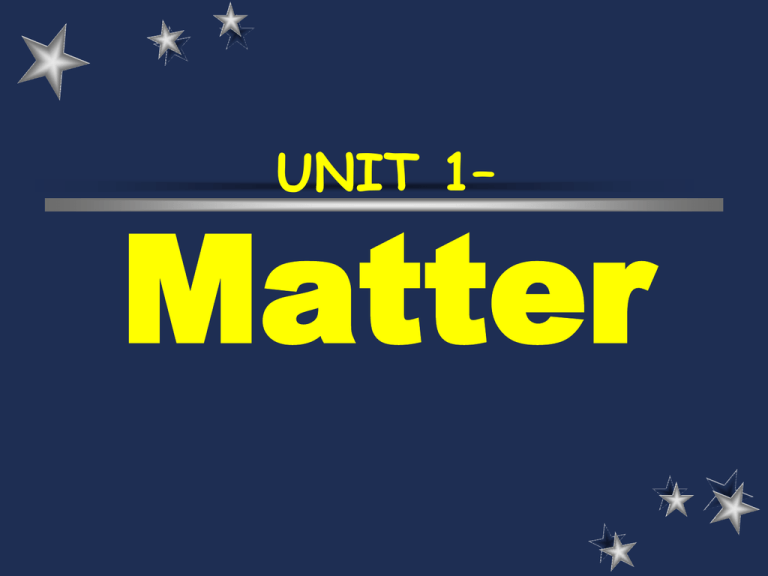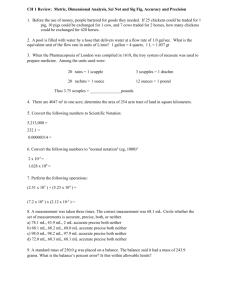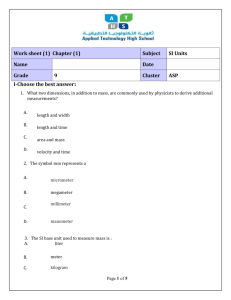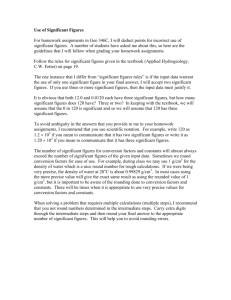ipc test___Unit 1 Matter-ALL notes_9-10-12
advertisement

UNIT 1– Matter What is matter anyway? Matter is ANYTHING that has MASS & takes up SPACE (has VOLUME) Four States of Matter Solids very low KE (kinetic energy) particles vibrate but can’t move around fixed shape fixed volume Four States of Matter Liquids low KE - particles can move over & around each other but are still close together variable shape fixed volume Four States of Matter Gases high KE - particles have enough energy to separate and move throughout container; so much so that gases are mostly empty space! variable shape variable volume Four States of Matter Plasma Highest KE - particles collide with enough energy to break into charged particles (+/-) gas-like, variable shape & volume stars, fluorescent light bulbs Fluids What is a fluid? a substance that can FLOW & has particles that are able to move around each other. What 2 phases of matter are considered FLUIDS? Liquids & Gases Properties of Fluids What is viscosity? The ability of a liquid to flow or the resistance to flow. (Honey is MORE viscous than water) What is buoyancy? The upward force a fluid exerts on an object. Properties of Fluids What 3 properties allow an object to be “buoyant”? 1. The buoyant force exerted upward on the object is ______________________ than the force downward of the object’s weight. 2. The ___________________ of the object is less than the _____________________ of the fluid. 3. The weight of the water displaced by the object is _________________ than the _____________ of the object. States of Matter…Test YOUR knowledge! Type of Matter Solid Liquid Gas Plasma Kinetic energy Shape Volume States of Matter…Test YOUR knowledge! Type of Matter Kinetic energy Shape Volume Solid Very low Definite/fixed Definite/fixed Liquid Low Indefinite/ not fixed/ variable Definite/fixed Gas High Indefinite/ Not fixed/ variable Indefinite/ Not fixed/ variable Plasma Very high Indefinite/ Not fixed/ variable Indefinite/ Not fixed/ variable Matter Flowchart MATTER yes MIXTURE yes Is the composition uniform? Homogeneous Mixture (solution) PURE SUBSTANCE no Heterogeneous Mixture Colloids no Can it be physically separated? yes Can it be chemically decomposed? Compound C. Johannesson Suspensions no Element Matter Flowchart Test yourself… graphite element pepper hetero. mixture sugar (sucrose) compound paint hetero. mixture soda solution Properties of & Changes in Matter… Density Intensive vs. Extensive Physical vs. Chemical DENSITY Density is the measure of the MASS of a substance to the VOLUME of a substance at a given temperature. Density is expressed in g/mL or kg/L for liquids and g/cm3 for solids. Density of a SUBSTANCE will determine if the substance will SINK or FLOAT in another substance. (recall buoyancy) Accuracy vs. Precision Accuracy - how close a measurement is to the accepted value ACCURATE = CORRECTNESS • Precision - how close a series of measurements are to each other PRECISE = CONSISTENT or REPRODUCIBLE Accurate & Precise Accurate, not Precise Precise, not accurate Neither Accurate nor Precise Example Problem To determine the density of a certain metal alloy, a chemist measures the mass and volume of each of four different samples of the alloy. The chemist obtains the density values shown in the following: Example Problem Sample Density (measured) 1 5.87 g/cm3 2 5.89 g/cm3 3 5.83 g/cm3 4 5.92g/cm 3 Example Problem Later, the chemist learns that the true density of the alloy is 5.62 g/cm3. Describe the chemist’s results in terms of accuracy and precision. a. accurate and precise b. accurate, but not precise c. precise, but not accurate d. neither accurate nor precise PHYSICAL CHANGES Physical Change changes the form of a substance without changing its identity EX: cutting, dissolving, grinding PHASE CHANGES Changes of state (phase changes) are physical changes that involve changes of energy. Phase Changes (ARE physical change) sublimation melting SOLID vaporization LIQUID freezing condensation deposition GAS CHEMICAL CHANGES Chemical Change changes the identity of a substance products have different properties EX: tarnishing, burning, corroding Physical vs. Chemical Indicators or Signs of a Chemical Change (*important…you will need to know this for the rest of the year!!!) NEW substance formed Change of color or odor Release or formation of a gas formation of a precipitate (solid that settles…yes, a suspension) change in light or heat Physical vs. Chemical CHANGE You try it…(not in notes) rusting iron chemical dissolving in water physical burning a log chemical melting ice physical grinding spices physical Physical vs. Chemical Physical Property can be observed without changing the identity of the substance Chemical Property describes the ability of a substance to undergo changes in identity Physical vs. Chemical PROPERTY You try it… melting point physical flammable chemical density physical magnetic physical tarnishes in air chemical Other properties Conductivity- the ability of energy to flow through something. Reactivity- how likely a substance is to react with other substances Boiling Point- the point when a liquid becomes a gas Freezing/Melting Point- the point when a liquid becomes a solid Mine Scientific Notation In science, numbers can be very small & very large (confusing!) Numbers can be expressed in Scientific Notation: Mx n 10 1 ≤ M < 10 +n: large # Scientific Notation To convert into Sci. Notation: Move decimal until there’s 1 digit to its left. (# of places moved = exponent) Large # (>1) positive exponent Small # (<1) negative exponent Only include sig figs. 65,000 kg 6.5 × 104 kg Scientific Notation Practice Problems 1. 2,400,000 mg 2.4 6 10 mg 2. 0.00256 kg 2.56 3. 7 10-5 km 0.00007 km 4. 6.2 104 mm 62,000 mm -3 10 kg Calculating with Scientific Notation (5.44 × 107 g) ÷ (8.1 × 104 mol) = Type on your calculator: 5.44 2nd EE 7 ÷ 8.1 2nd EE 4 ENTER = 671.6049383 = 670 g/mol = 6.7 × 102 g/mol





